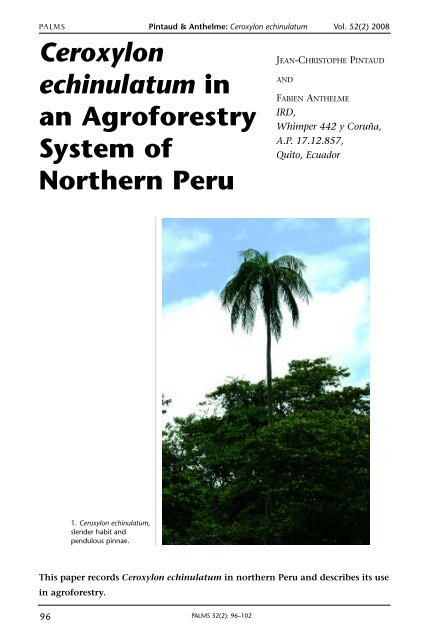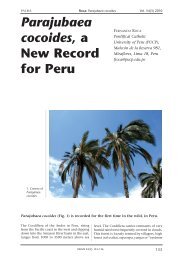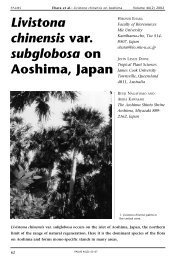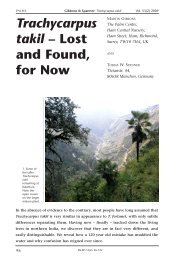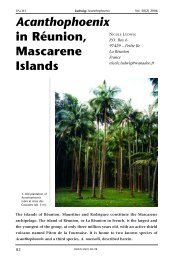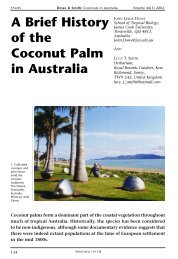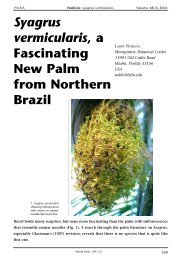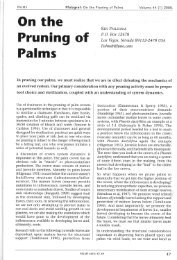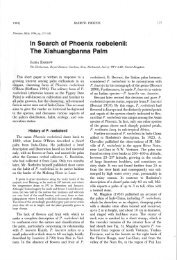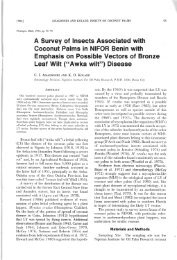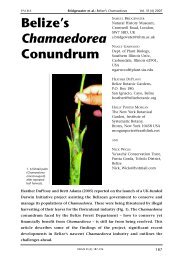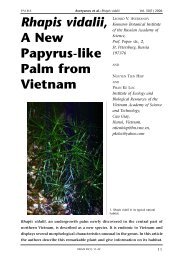Ceroxylon echinulatum in an - International Palm Society
Ceroxylon echinulatum in an - International Palm Society
Ceroxylon echinulatum in an - International Palm Society
You also want an ePaper? Increase the reach of your titles
YUMPU automatically turns print PDFs into web optimized ePapers that Google loves.
PALMS P<strong>in</strong>taud & Anthelme: <strong>Ceroxylon</strong> <strong>ech<strong>in</strong>ulatum</strong> Vol. 52(2) 2008<br />
<strong>Ceroxylon</strong><br />
<strong>ech<strong>in</strong>ulatum</strong> <strong>in</strong><br />
<strong>an</strong> Agroforestry<br />
System of<br />
Northern Peru<br />
JEAN-CHRISTOPHE PINTAUD<br />
AND<br />
FABIEN ANTHELME<br />
IRD,<br />
Whimper 442 y Coruña,<br />
A.P. 17.12.857,<br />
Quito, Ecuador<br />
1. <strong>Ceroxylon</strong> <strong>ech<strong>in</strong>ulatum</strong>,<br />
slender habit <strong>an</strong>d<br />
pendulous p<strong>in</strong>nae.<br />
This paper records <strong>Ceroxylon</strong> <strong>ech<strong>in</strong>ulatum</strong> <strong>in</strong> northern Peru <strong>an</strong>d describes its use<br />
<strong>in</strong> agroforestry.<br />
96<br />
PALMS 52(2): 96–102
PALMS P<strong>in</strong>taud & Anthelme: <strong>Ceroxylon</strong> <strong>ech<strong>in</strong>ulatum</strong> Vol. 52(2) 2008<br />
The genus <strong>Ceroxylon</strong> currently comprises 11<br />
species restricted to the Andes, from 800 m to<br />
3500 m elevation but most common between<br />
1500 <strong>an</strong>d 3000 m, from Venezuela to Bolivia.<br />
<strong>Ceroxylon</strong> is still <strong>in</strong>completely known <strong>in</strong> the<br />
southern part of its r<strong>an</strong>ge (Peru <strong>an</strong>d Bolivia).<br />
Henderson et al. (1995) reported four species<br />
of <strong>Ceroxylon</strong> from Peru (C. parvifrons, C. parvum,<br />
C. vogeli<strong>an</strong>um <strong>an</strong>d C. weberbaueri). However,<br />
recent field work <strong>in</strong> the Peruvi<strong>an</strong> Andes has<br />
shown that the genus is much more diverse <strong>in</strong><br />
this country <strong>an</strong>d <strong>in</strong>cludes species previously<br />
known from Ecuador <strong>an</strong>d possibly Colombia,<br />
as well as undescribed ones (Fig. 2). <strong>Ceroxylon</strong><br />
<strong>ech<strong>in</strong>ulatum</strong> was considered to be endemic to<br />
Ecuador (Borchsenius et al. 1998), although it<br />
was collected <strong>in</strong> Zamora-Ch<strong>in</strong>chipe prov<strong>in</strong>ce<br />
very close to the border with Peru. We<br />
encountered this species on the other side of<br />
the border, <strong>in</strong> Cajamarca region of Peru. Other<br />
fieldwork data (K. Mejía pers. com.) suggest<br />
that this species is relatively widespread but<br />
very patchily distributed <strong>in</strong> northern Peru. It<br />
is easily recognized by its tall <strong>an</strong>d slender habit,<br />
regularly arr<strong>an</strong>ged pendulous p<strong>in</strong>nae <strong>an</strong>d<br />
warty fruits (Figs. 1 & 2).<br />
M<strong>an</strong>y <strong>Ceroxylon</strong> species are considered<br />
end<strong>an</strong>gered due to habitat loss <strong>an</strong>d destructive<br />
use throughout the r<strong>an</strong>ge of the genus<br />
(Gale<strong>an</strong>o & Bernal 2005). However, these<br />
beautiful <strong>an</strong>d useful palms are often cultivated<br />
or m<strong>an</strong>aged <strong>in</strong> some way, prevent<strong>in</strong>g local<br />
ext<strong>in</strong>ction <strong>in</strong> m<strong>an</strong>y places. Documented<br />
threats on the species <strong>an</strong>d susta<strong>in</strong>able uses are<br />
summarized <strong>in</strong> table 1. <strong>Ceroxylon</strong> <strong>ech<strong>in</strong>ulatum</strong><br />
<strong>in</strong> northern Cajamarca is a good example of<br />
both the destructive <strong>an</strong>d susta<strong>in</strong>able use of<br />
these Ande<strong>an</strong> palms. The region has been<br />
heavily deforested dur<strong>in</strong>g past decades so that<br />
the only remn<strong>an</strong>ts of the orig<strong>in</strong>al <strong>Ceroxylon</strong><br />
populations are tall, old specimens left <strong>in</strong><br />
pasture, where they c<strong>an</strong>not regenerate <strong>an</strong>d<br />
progressively die (Back Cover). However,<br />
<strong>Ceroxylon</strong> <strong>ech<strong>in</strong>ulatum</strong> is now <strong>in</strong>tegrated <strong>in</strong><br />
coffee agroforestry as a cultivated component,<br />
allow<strong>in</strong>g its survival despite the progressive<br />
ext<strong>in</strong>ction of the natural populations.<br />
The agroforestry system of the upper<br />
Urumba valley<br />
Accord<strong>in</strong>g to local farmers, this sector of<br />
northern Cajamarca was almost prist<strong>in</strong>e 50<br />
years ago. People, especially from the city of<br />
Hu<strong>an</strong>cabamba <strong>an</strong>d other localities of the<br />
north-western Andes of Peru, beg<strong>an</strong> to move<br />
<strong>in</strong> search of new <strong>in</strong>come sources, establish<strong>in</strong>g<br />
pastures <strong>an</strong>d coffee pl<strong>an</strong>tations, <strong>an</strong>d<br />
progressively develop<strong>in</strong>g S<strong>an</strong> Ignacio from a<br />
small village to a signific<strong>an</strong>t urb<strong>an</strong> centre.<br />
Dur<strong>in</strong>g the process, they ended up cutt<strong>in</strong>g<br />
almost all primary forest. By the end of the<br />
1980s, the upper Urumba valley was fac<strong>in</strong>g<br />
serious problems of loss of soil fertility <strong>an</strong>d<br />
widespread erosion, so that the future of<br />
agriculture <strong>in</strong> the area seemed bleak. However,<br />
a conjunction of <strong>in</strong>stitutional <strong>an</strong>d nongovernmental<br />
<strong>in</strong>itiatives s<strong>in</strong>ce the early 1990s<br />
allowed a spectacular move toward long-term<br />
susta<strong>in</strong>ability of agriculture <strong>an</strong>d l<strong>an</strong>d<br />
m<strong>an</strong>agement <strong>in</strong> the valley (Gallo 2005). This<br />
was largely achieved through participative<br />
programs m<strong>an</strong>aged by the <strong>in</strong>habit<strong>an</strong>t<br />
Table 1. Threats <strong>an</strong>d uses of <strong>Ceroxylon</strong> species.<br />
Species Habitat loss Destructive use Non-destructive Cultivation<br />
(<strong>in</strong>clud<strong>in</strong>g forest (stem <strong>an</strong>d uses (a: fruits; (a: <strong>in</strong> agroforests;<br />
clear<strong>an</strong>ce leav<strong>in</strong>g young leaves) b: <strong>in</strong>florescences) b: as ornamental)<br />
adult palms <strong>in</strong><br />
pastures)<br />
C. alp<strong>in</strong>um severe severe a a, b<br />
C. amazonicum low m<strong>in</strong>or uses m<strong>in</strong>or uses not cultivated<br />
C. ceriferum moderate to severe severe a b<br />
C. <strong>ech<strong>in</strong>ulatum</strong> severe severe a, b a<br />
C. parvifrons moderate moderate to high m<strong>in</strong>or uses b<br />
C. parvum moderate severe m<strong>in</strong>or uses not cultivated<br />
C. qu<strong>in</strong>diuense severe moderate a b<br />
C. sasaimae habitat destroyed low m<strong>in</strong>or uses a, b<br />
C. ventricosum severe severe a b<br />
C. vogeli<strong>an</strong>um moderate moderate to high a b (rarely)<br />
C. weberbaueri severe not documented not documented not cultivated<br />
97
PALMS P<strong>in</strong>taud & Anthelme: <strong>Ceroxylon</strong> <strong>ech<strong>in</strong>ulatum</strong> Vol. 52(2) 2008<br />
2. Small verrucose fruits of <strong>Ceroxylon</strong> <strong>ech<strong>in</strong>ulatum</strong> (left) compared with the larger <strong>an</strong>d smooth ones of <strong>an</strong>other,<br />
undeterm<strong>in</strong>ed species grow<strong>in</strong>g <strong>in</strong> the same region (right).<br />
themselves, <strong>in</strong> the form of cooperatives,<br />
mothers’ <strong>an</strong>d students’ clubs, agroforestry<br />
commities etc. The diversity of action<br />
implemented is astound<strong>in</strong>g. Some of them aim<br />
at biodiversity conservation, such as the<br />
protection of the spectacled bear (previously<br />
hunted) <strong>an</strong>d of remn<strong>an</strong>t patches of cloud<br />
forests, while others are more directly profitoriented<br />
such as timber pl<strong>an</strong>tations of<br />
Schizolobium amazonicum (fast-grow<strong>in</strong>g legume<br />
tree). However, what really reshaped the<br />
l<strong>an</strong>dscape is the evolution of coffee<br />
production, which reached new <strong>in</strong>ternational<br />
markets, especially that of high-quality org<strong>an</strong>ic<br />
fair-trade coffee, result<strong>in</strong>g <strong>in</strong> a cont<strong>in</strong>uous need<br />
for new cultivation space. With the<br />
disappear<strong>an</strong>ce of natural forests, org<strong>an</strong>ic coffee<br />
cultivation developed f<strong>in</strong>ally at the expense<br />
of pasture. Such cultivation is established<br />
under the cover of Inga edulis, a legume tree<br />
that provides the appropriate shade while<br />
occupy<strong>in</strong>g limited space at ground level th<strong>an</strong>ks<br />
3. Material from <strong>Ceroxylon</strong> sp. trunks prepared for sale at Ocol village, Peru.<br />
98
PALMS P<strong>in</strong>taud & Anthelme: <strong>Ceroxylon</strong> <strong>ech<strong>in</strong>ulatum</strong> Vol. 52(2) 2008<br />
Table 2. Ma<strong>in</strong> components of the agroforestry system at S<strong>an</strong> Ignacio, Peru. (C = cash<br />
crop, D = domestic use).<br />
Species Familly Vernacular name Use<br />
C<strong>an</strong>opy <strong>an</strong>d emergent trees<br />
Inga edulis Fabaceae Guabo, huabo Shade, nitrogen fixation,<br />
edible fruits, wood (C, D)<br />
Erythr<strong>in</strong>a edulis Fabaceae Pajuro Shade, nitrogen fixation,<br />
edible fruits, wood (C, D)<br />
Cedrela odorata Meliaceae Cedro Timber (C & D)<br />
Ceiba sp. Bombacaceae Ceibo Not recorded<br />
Ochroma pyramidale Bombacaceae Balsa Timber (C & D)<br />
M<strong>an</strong>gifera <strong>in</strong>dica Anacardiaceae M<strong>an</strong>go Fruits (C & D)<br />
Bactris gasipaes Arecaceae Chonta Fruits, palm-hearts,<br />
wood (C & D)<br />
Bactris setulosa Arecaceae Chontilla Not recorded<br />
<strong>Ceroxylon</strong> <strong>ech<strong>in</strong>ulatum</strong> Arecaceae <strong>Palm</strong>a Wood (construction,<br />
C, D)<br />
Guadua <strong>an</strong>gustifolia Poaceae Guadua Wood (construction,<br />
C, D)<br />
Upper understory (large shrubs <strong>an</strong>d small trees, v<strong>in</strong>es)<br />
Coffea arabica Rubiaceae Café Fruits (C)<br />
Bixa orell<strong>an</strong>a Bixaceae Achiote Sta<strong>in</strong>, food color, D<br />
Psidium guayava Myrtaceae Guyava Fruits (C & D)<br />
Caesalp<strong>in</strong>ia sp<strong>in</strong>osa Fabaceae Tara Fruits (gum & t<strong>an</strong>n<strong>in</strong>s),<br />
C<br />
Passiflora sp. Passifloraceae Gr<strong>an</strong>adilla Fruits (C, D)<br />
Lower understorey (small shrubs <strong>an</strong>d herbs)<br />
Sol<strong>an</strong>um sessiliflorum Sol<strong>an</strong>aceae Cocona Fruits (C, D)<br />
Sol<strong>an</strong>um quitoense Sol<strong>an</strong>aceae Nar<strong>an</strong>jilla Fruits (C, D)<br />
Saccharum offic<strong>in</strong>arum Poaceae Caña azucar Stem juice (sugar, D)<br />
An<strong>an</strong>as comosus Bromeliaceae Piña Fruits (C, D)<br />
Nicolaia elatior Z<strong>in</strong>giberaceae Not recorded Stem juice (medic<strong>in</strong>al, D)<br />
Colocasia esculenta Araceae Vituca Arrow root (C, D)<br />
X<strong>an</strong>thosoma sagittifolium Araceae Songo Jivaro Arrow root (D)<br />
Musa × paradisiaca Musaceae Plat<strong>an</strong>o Fruits (C, D)<br />
Musa acum<strong>in</strong>ata × balbisi<strong>an</strong>a Musaceae Gu<strong>in</strong>eo gr<strong>an</strong>o de Fruits (C, D)<br />
oro<br />
to its spread<strong>in</strong>g habit, <strong>an</strong>d simult<strong>an</strong>eously<br />
enrich<strong>in</strong>g the soil as a nitrogen-fix<strong>in</strong>g pl<strong>an</strong>t.<br />
Moreover, it produces edible fruits <strong>an</strong>d useful<br />
wood. The result is <strong>an</strong> almost complete<br />
reforestation of the area, but <strong>in</strong> the form of a<br />
totally artificial <strong>an</strong>d carefully m<strong>an</strong>aged<br />
agroforestry system (Perfecto et al. 2005).<br />
While the system is basically two-layered with<br />
a monodom<strong>in</strong><strong>an</strong>t c<strong>an</strong>opy of Inga edulis <strong>an</strong>d<br />
<strong>an</strong> understorey of coffee trees, there is a<br />
multitude of m<strong>in</strong>or species distributed from<br />
the herbaceous to the emergent layers of the<br />
agroforest, each one hav<strong>in</strong>g a specific use, but<br />
also contribut<strong>in</strong>g to ecosystem function<strong>in</strong>g by<br />
restor<strong>in</strong>g the diversity of life forms of a natural<br />
forest. This complex org<strong>an</strong>ization ultimately<br />
controls pests naturally <strong>an</strong>d ma<strong>in</strong>ta<strong>in</strong>s soil<br />
fertility, while provid<strong>in</strong>g m<strong>an</strong>y domestic<br />
99
PALMS P<strong>in</strong>taud & Anthelme: <strong>Ceroxylon</strong> <strong>ech<strong>in</strong>ulatum</strong> Vol. 52(2) 2008<br />
4 (top). Young pl<strong>an</strong>tation of <strong>Ceroxylon</strong> <strong>ech<strong>in</strong>ulatum</strong> for domestic use <strong>in</strong> <strong>an</strong> agroforestry plot, established from<br />
the seeds of the mature <strong>in</strong>dividuals visible <strong>in</strong> the background. 5 (bottom). Farm house show<strong>in</strong>g the use of<br />
material from the outer part of the trunk of <strong>Ceroxylon</strong> <strong>ech<strong>in</strong>ulatum</strong>.<br />
100
PALMS P<strong>in</strong>taud & Anthelme: <strong>Ceroxylon</strong> <strong>ech<strong>in</strong>ulatum</strong> Vol. 52(2) 2008<br />
resources to the farmers <strong>an</strong>d a variety of yearround<br />
side <strong>in</strong>comes (Table 2). Nowadays, the<br />
m<strong>an</strong>agement of the upper Urumba valley,<br />
which beg<strong>an</strong> as <strong>an</strong> ecological disaster, is<br />
regarded as a model of susta<strong>in</strong>able<br />
development.<br />
M<strong>an</strong>agement of <strong>Ceroxylon</strong> <strong>ech<strong>in</strong>ulatum</strong> <strong>in</strong><br />
coffee agroforestry systems<br />
With the disappear<strong>an</strong>ce of natural forest, the<br />
need for wood, especially for construction<br />
became acute <strong>in</strong> the upper Urumba valley. In<br />
order to supply wood, timber species were<br />
<strong>in</strong>troduced (Cedrela odorata, Schizolobium<br />
amazonicum, Eucalyptus spp.), but local wild<br />
species, <strong>in</strong> particular <strong>Ceroxylon</strong> <strong>ech<strong>in</strong>ulatum</strong>,<br />
were also put <strong>in</strong>to cultivation. <strong>Ceroxylon</strong> species<br />
are very much appreciated for construction <strong>in</strong><br />
the Andes, but are most often used<br />
destructively for this purpose, eventually<br />
elim<strong>in</strong>at<strong>in</strong>g natural populations. Only when<br />
this happens, the option of cultivation sounds<br />
attractive to local people. The rarity of<br />
<strong>Ceroxylon</strong> pl<strong>an</strong>ts also me<strong>an</strong>s <strong>an</strong> import<strong>an</strong>t<br />
<strong>in</strong>crease <strong>in</strong> stem price, which makes cultivation<br />
a good bus<strong>in</strong>ess. In S<strong>an</strong> Ignacio, one stem from<br />
a cultivated pl<strong>an</strong>t is sold for $50, while <strong>in</strong> Ocol,<br />
<strong>an</strong>other place where there are still extensive<br />
natural populations, the stem price from wild<br />
pl<strong>an</strong>ts is only $10 (Fig. 3). In the upper<br />
Urumba valley (1600–1800 m elevation),<br />
farmers have <strong>an</strong> <strong>in</strong>terest<strong>in</strong>g way of m<strong>an</strong>ag<strong>in</strong>g<br />
<strong>Ceroxylon</strong> <strong>ech<strong>in</strong>ulatum</strong>. Their dilemma is that<br />
they need the wood to build their houses, but<br />
the root system of the palm is extensive,<br />
absorbs much of the soil water <strong>an</strong>d is<br />
ultimately detrimental to coffee cultivation,<br />
the basic source of <strong>in</strong>come. As <strong>Ceroxylon</strong><br />
<strong>ech<strong>in</strong>ulatum</strong> is a fast grow<strong>in</strong>g species, farmers<br />
tend to cultivate it temporarily for their<br />
specific needs; it needs to be pl<strong>an</strong>ned at least<br />
15 years <strong>in</strong> adv<strong>an</strong>ce. Such long term pl<strong>an</strong>n<strong>in</strong>g<br />
is not widespread <strong>in</strong> the rural Andes. For<br />
example, if a farmer needs 30 <strong>Ceroxylon</strong> trees<br />
to build a new, larger house, he will pl<strong>an</strong>t them<br />
<strong>in</strong> a plot (Fig. 4), accept<strong>in</strong>g a decrease of coffee<br />
yield, until cutt<strong>in</strong>g them <strong>an</strong>d <strong>in</strong>creas<strong>in</strong>g aga<strong>in</strong><br />
the coffee’s productivity. A few adult specimens<br />
are however conserved as seed source for future<br />
uses (Fig. 4). The palm is ma<strong>in</strong>ly propagated<br />
by tr<strong>an</strong>spl<strong>an</strong>t<strong>in</strong>g the seedl<strong>in</strong>gs that grow<br />
spont<strong>an</strong>eously <strong>in</strong> the agroforest. Alternatively,<br />
the seeds are sown after digestion of the fruits<br />
by parrots that live <strong>an</strong>d feed <strong>in</strong> the agrosystem.<br />
Some aspects of the use of trunk material c<strong>an</strong><br />
be seen <strong>in</strong> Figs. 5 <strong>an</strong>d 6.<br />
6. Wall made of <strong>Ceroxylon</strong> material.<br />
101
PALMS P<strong>in</strong>taud & Anthelme: <strong>Ceroxylon</strong> <strong>ech<strong>in</strong>ulatum</strong> Vol. 52(2) 2008<br />
In conclusion, we confirmed the presence of<br />
<strong>Ceroxylon</strong> <strong>ech<strong>in</strong>ulatum</strong> <strong>in</strong> Peru <strong>an</strong>d documented<br />
its <strong>in</strong>clusion <strong>in</strong> agroforestry systems. As with<br />
other Ande<strong>an</strong> palms (Svenn<strong>in</strong>g 1998), the<br />
genus <strong>Ceroxylon</strong> <strong>in</strong> general is end<strong>an</strong>gered<br />
because its distribution is restricted to a region<br />
of South America that has suffered a high level<br />
of hum<strong>an</strong> pressure for a long time. A large part<br />
of the natural habitat of <strong>Ceroxylon</strong> has been<br />
converted <strong>in</strong>to agricultural systems, <strong>an</strong>d thus<br />
its survival relies <strong>in</strong>creas<strong>in</strong>gly on propagation<br />
by farmers, <strong>an</strong>d several species have already<br />
been <strong>in</strong>cluded <strong>in</strong> coffee agroforestry systems<br />
(Gale<strong>an</strong>o & Bernal 2005).<br />
Acknowledgments<br />
We th<strong>an</strong>k Betty Millán (S<strong>an</strong> Marcos University,<br />
Lima) for her help <strong>an</strong>d participation with field<br />
work on <strong>Ceroxylon</strong> <strong>in</strong> northern Peru, <strong>an</strong>d<br />
Kember Mejía (IIAP, Iquitos) for shar<strong>in</strong>g<br />
<strong>in</strong>formation about <strong>Ceroxylon</strong> populations <strong>in</strong><br />
Amazonas <strong>an</strong>d S<strong>an</strong> Mart<strong>in</strong> regions.<br />
LITERATURE CITED<br />
BORCHSENIUS F., H. BORGTOFT PEDERSEN AND H.<br />
BALSLEV. 1998. M<strong>an</strong>ual to the <strong>Palm</strong>s of<br />
Ecuador. AAU Reports 37. Aarhus University<br />
<strong>an</strong>d PUCE. 217 p.<br />
GALEANO G. AND R. BERNAL. 2005. <strong>Palm</strong>as. In:<br />
CALDERON E., G. GALEANO AND N. GARCIA EDS.<br />
Libro rojo de pl<strong>an</strong>tas de Colombia Vol. 2:<br />
<strong>Palm</strong>as, frailejones y zamias. Instituto<br />
Alex<strong>an</strong>der von Humboldt, Bogota,<br />
Colombia.<br />
GALLO L. M. 2005. La <strong>in</strong>stitucionalidad regional<br />
en el corredor económico Jaen–S<strong>an</strong><br />
Ignacio–Condorc<strong>an</strong>quí, Perú. Tésis de grado<br />
de magister en gestión de desarrollo rural y<br />
agricultura sustentable. Universidad Católica<br />
de Temuco, Chile, 61 p.<br />
HENDERSON A., G. GALEANO AND R. BERNAL. 1995.<br />
Field guide to the palms of the Americas.<br />
Pr<strong>in</strong>ceton University Press, USA.<br />
PERFECTO J., J. VENDERMEER, M. MAS AND L.S.<br />
PINTO. 2005. Biodiversity, yield, <strong>an</strong>d shade<br />
coffee certification. Ecological Economics<br />
54: 435–446.<br />
SVENNING J.C. 1998. The effect of l<strong>an</strong>d use on<br />
the local distribution of palm species <strong>in</strong> <strong>an</strong><br />
Ande<strong>an</strong> ra<strong>in</strong> forest fragment <strong>in</strong> northwestern<br />
Ecuador. Biodiversity <strong>an</strong>d Conservation 7:<br />
1529–1537.<br />
102


